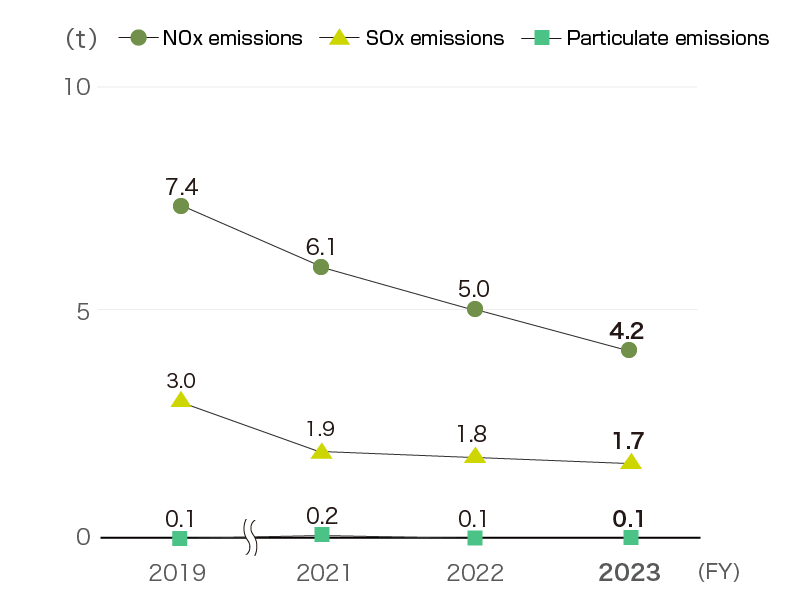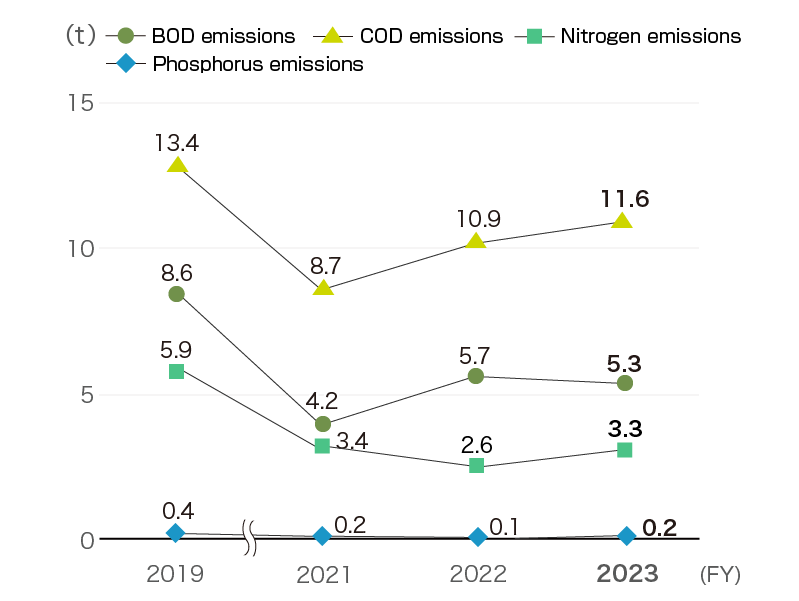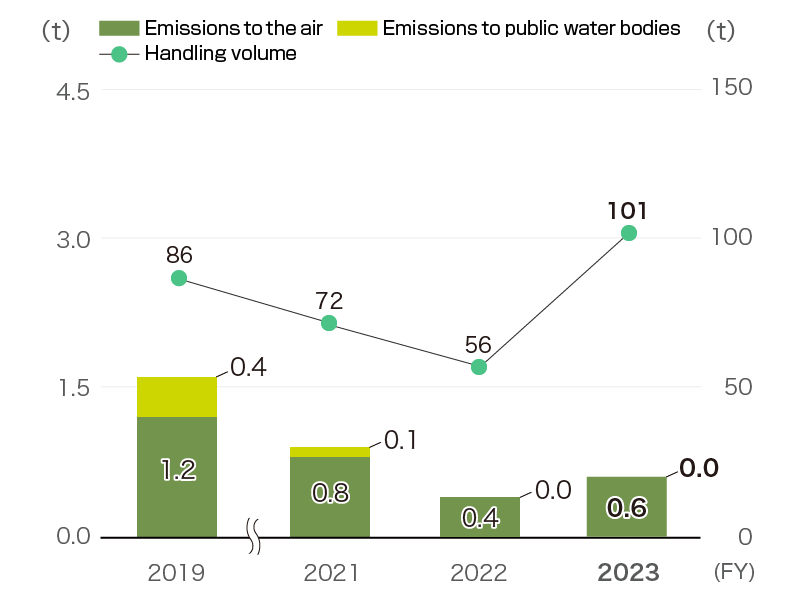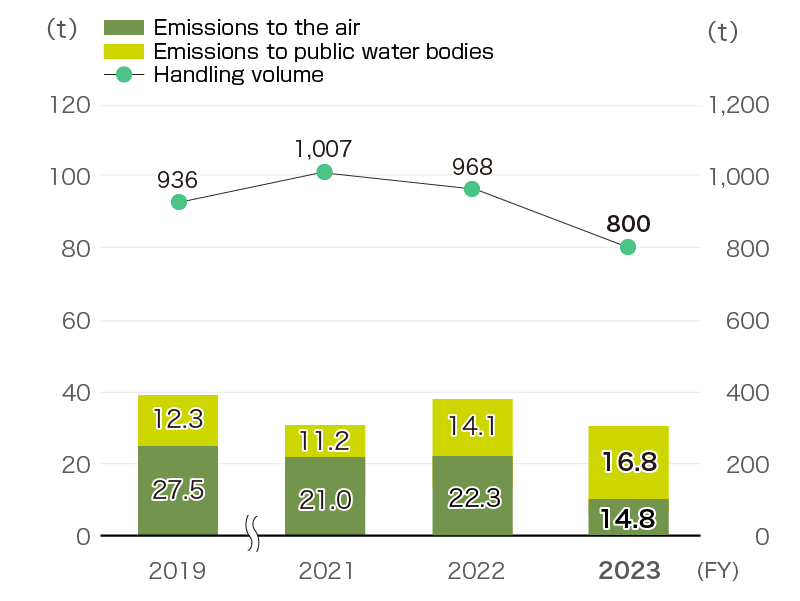
Environment Initiatives to Prevent Pollution
The Mitsubishi Tanabe Pharma Group works to prevent air, water, soil, noise, vibration, and odor pollution and each base sets stricter voluntary standards than the legal emissions standards for pollutants and applies them daily. Additionally, we have put goals in place for the prevention of environmental pollution for the Medium-Term Environmental Action Plan 21-25, and we are working to achieve them.
We also work to prevent the external leakage of PRTR substances and VOCs, which are regulated by laws, and to reduce the amount of these substances that are released into the environment.
Prevention of Air Pollution
The Group controls the generation of soot and smoke by reducing the operating time of fuel-driven boilers, water heaters and coolers, and power generators.
At domestic bases, we reduce the concentration of air pollutants in soot and smoke by mainly converting the fuel for these soot and smoke generating devices from oil to gas.
We have also enhanced measures to prevent environmental pollution in soot and smoke generating devices at our overseas bases by addressing the increasingly strict regulations of each country and improving and updating the devices as needed.
Emissions of air pollutants by domestic bases

Prevention of Water Pollution
To the extent possible, harmful substances discharged from the Group’s production and research bases are treated as industrial waste on disposal to prevent contamination with wastewater. Also, we adjust the pH of wastewater and purify it before discharge to comply with emission standards. Especially at Mitsubishi Tanabe Pharma Factory (the Onoda and Yoshitomi plants) and Mitsubishi Tanabe Pharma Indonesia (Bandung plant), where wastewater is discharged into public water bodies, wastewater undergoes activated sludge treatment, and we comply with emission standards for public water bodies that are stricter than that for sewage discharge. At two domestic plants, we constantly measure the pH, COD, nitrogen, and phosphorus of the wastewater, and when we detect an abnormality, we immediately stop its discharge and store it in a reserve water tank.
Environmental impact on public water bodies (domestic)

Prevention of Soil and Groundwater Pollution
The Group conducts land use history surveys of domestic bases where it owns land to identify soil contamination risk. If the survey finds that the soil or groundwater is contaminated, we notify the authorities and take appropriate action.
Response to the soil and groundwater pollution implemented in fiscal 2023
| Base | Activity | Implemented content |
|---|---|---|
| Taiwan Tanabe Seiyaku Hsinchu Plant | Groundwater purification | The plant has completed the purification of groundwater pollution found in 2019, and has been inspected by authorities |
| Mitsubishi Tanabe Pharma Yoshitomi Plant | Soil contamination survey | Updated geo-historical surveys in conjunction with the construction of new buildings at a company on the worksite (no soil contamination found) |
Prevention of Noise, Vibration, and Odor
At our domestic bases, we monitor noise, vibration, and odor in accordance with related laws and regulations and confirm that they are within the established standards.
PRTR Substances and VOCs
Based on the Law concerning Pollutant Release and Transfer Register/PRTR Law, the Group manages the amount of PRTR substances handled at our facilities and the emissions to the environment, and properly notifies the prefectures where we are located.
All organic waste solvents containing PRTR substances discharged from the research centers are treated as industrial waste to minimize the discharge to public water areas.
We are also studying the manufacturing processes and reducing the amount of target organic solvents used.
We are reducing VOC emissions by managing emissions and the amount handled, setting up collection facilities, and reducing emissions into the natural environment.
Emission of PRTR substances (domestic)

Emission of VOC (excluding PRTR substances) (domestic)

PCB Disposal
We completed all disposal of high-concentration PCB (polychlorinated biphenyl) devices at the Group’s domestic bases.
Furthermore, we are conducting a confirmation survey of items with a low concentration of PCBs, including notification from the Ministry of Economy, Trade and Industry (March 31, 2022), and plan to move ahead steadily to complete disposal by March 31, 2027, the disposal deadline.
Asbestos
Surveys for sprayed asbestos have been conducted at domestic Group bases in the past under the Ordinance on Prevention of Asbestos Hazards, and we are taking relevant measures to prevent asbestos scattering. Additionally, when removing or renovating facilities, we check for the presence of asbestos in the sprayed materials, insulation, and building materials to be moved, and report the results of these checks to the government.
Genetically Modified Organisms, Pathogens, etc.
The Group is engaged in drug discovery research aimed at various modalities, and opportunities to handle various research materials and samples are increasing. In the use of genetically modified organisms, we have established in-house regulations based on relevant government and ministerial ordinances, such as the “Law Concerning the Conservation and Sustainable Use of Biological Diversity through Regulations on the Use of Living Modified Organisms (Cartagena Act),” which we comply with. Moreover, the in-house Ethics Review Committee prevents the spread of living modified organisms by receiving preliminary reviews of measures to prevent the spread of these organisms into the environment.
In addition, regarding the use of pathogens and research materials and samples that may contain them, we have established internal regulations based on laws and regulations including the “Act on the Prevention of Infectious Diseases and Medical Care for Patients with Infectious Diseases (the Infectious Diseases Control Law)” and prevent the leakage of pathogens.
